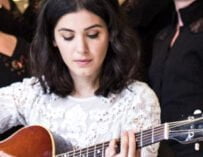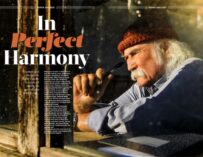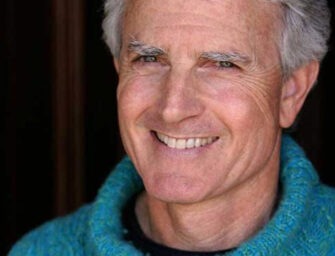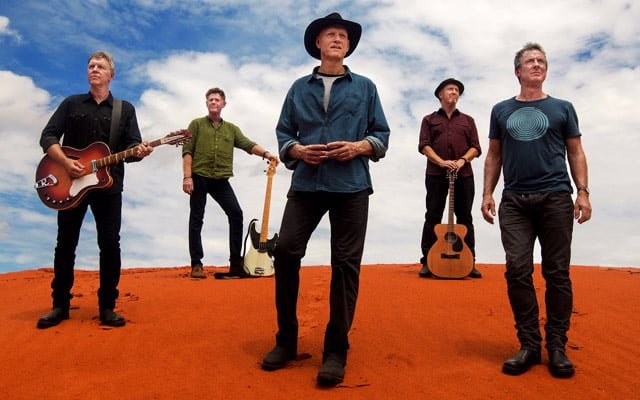The five-Grammy-winning singer-songwriter sprinkled some of his brilliance over the Great American Songbook. Here, he told us all about it
Just listing his achievements doesn’t do James Taylor justice as an artist and songwriter. Over 100 million records sold, five Grammy Awards and an induction into the Rock and Roll Hall of Fame might sound impressive, but to really understand his influence you have to dive deep into his catalogue, not least his early albums Sweet Baby James (featuring the much-loved Fire And Rain) and Mud Slide Slim And The Blue Horizon.
As well as a revered writer, Taylor is also acknowledged as being one of the finest song interpreters in the business. From his iconic version of Carole King’s You’ve Got A Friend to his reworking of the Holland-Dozier-Holland classic How Sweet It Is (To Be Loved By You), he just has the knack of remaining true to a song’s essence while imbuing it with something of his own spirit. That talent has come in very handy on his release American Standard.
The album contains 14 songs plucked from the Great American Songbook. Featuring tracks written by titans such as Richard Rodgers, Oscar Hammerstein II, Jerome Kern, Arthur Herzog Jr and Lorenz Hart, Taylor has concentrated on their arrangements and, together with co-producers Dave O’Donnell and John Pizzarelli, turned them into subtle guitar classics.
Shortly before the album’s release we had the chance to chat with James about the record and how working on other people’s songs can improve your own writing skills…
See tickets for James Taylor’s first UK show in 3 years
What is it about these songs, and era of music, which makes them stand the test of time and remain so iconic?
“One of the reasons I feel strongly about this material, what’s generally referred to as standards or ‘The American Songbook’, is that these songs come from a time when songwriting was, I think, at its apex. It was the high point for songwriting as I know it. People like Cole Porter, the Gershwin Brothers, Rodgers and Hammerstein, Lerner and Loewe, Frank Lesser, they were really as good as songwriting got in terms of lyric, melody and chord changes.
“I think that one of the reasons for that is these songs were written to be performed by any number of people – they were written as part of a play. Nowadays we don’t listen so much to songs, we listen to recorded performances by specific artists. Many of these songs were written for musicals, to be performed by any number of people, or as sheet music for someone to play at the piano at a time when recorded music wasn’t as good as live music, so I think that a lot more was expected of the song itself. I think that this is the apex of popular songwriting, these songs.”
Does your knowledge of the songs predate your career, did they influence your own writing or have you come to them subsequently?
“They were part of my family record collection and they’re the first things that I heard. So not only are they my musical foundation, but my entire generation – Lennon & McCartney, Donald Fagen, Randy Newman, the songwriters that I admire… Paul Simon, Joni Mitchell… from my generation, this is basically their foundation too.
“These are the songs that informed their songwriting. I think that songwriting today is pretty primitive. Mainly, what we’re listening to is the performance of the singer, and we have great singers today. We’re listening to the production value of it and the bells and whistles of that production, audio tricks and stuff like that, but the songwriting itself, that has fallen off in my opinion.”

James Taylor in Songwriting Magazine Autumn 2020: “I think that songwriting today is pretty primitive.”
Was that part of your motivation to record these songs, to remind everyone how great they are?
“These are songs that I learned when I was learning to play the guitar, so some of these arrangements I’ve had for literally sixty years. So that’s the organising principle behind the album, it’s a guitar album of my guitar arrangements of these songs, the most recent is either Teach Me The Night or Moon River, I’m not sure, but these are songs that I had arrangements for on the guitar and I got together with another great guitarist and the two of us made a guitar album.”
Was there a larger collection of songs which you had to whittle down or were you always set on the 14 that made the album?
“We recorded 22 songs, I think, but then we focused on our favourites and narrowed it down to 17 songs and then cut off another 3. We finished 17 of them, but I’ve known these songs for a long time.
“God Bless The Child, we played that in my band The Flying Machine in 1966 in New York City in Greenwich Village. We played Hoagy Carmichael songs too: Baltimore Oriole, The Nearness Of You, we had a number. I’ve always loved these songs. It’s the sophistication of the changes. I think when these songs were reinterpreted by the jazz greats, the high point of the musical arrangement of these songs, the chords for them comes from Bill Evans and his piano, the way he treated this catalogue.”
Do you think you can become a better songwriter yourself by learning and arranging existing songs like these?
“You know, if you’re familiar with these songs harmonically and lyrically and in terms of the melody, yeah, I think it is good to know about this level of songwriting for sure.”
Has that process ever helped you come up with one of your own songs?
“Absolutely. A song of mine, Mean Old Man from October Road. A number of songs.”
Is there a sense that you have to do these great songs justice?
“Oh yeah. If you’re going to cover a song, you have to bring something new to it. It’s no good trying to copy and recreate somebody else’s version of it. I also think that a lot of people make standards albums, they pick a song, they pick a key, they give it to an arranger to put it together and then they come and stick their voice on it. Sometimes that can be great but there’s nothing new about it. This is a very specific treatment of these songs as guitar arrangements.”
Were there any which proved particularly tricky or interesting when it came to putting the arrangements together?
“Absolutely, all of them. All of them, by modern standards, are very sophisticated you know. Sorry With A Fringe On Top, for instance… not only are the chords demanding but it’s also a type of rhythm and a musical style song that is not en vogue now. So it was hard to get into the frame of mind that sang that way, it was almost as if it came from another time.
“I guess Almost Like Being In Love too. Our version of Over The Rainbow, I don’t think it stays on one chord for more than a half note. It’s very rangy. That’s one of the points about these songs, they’re very interesting to play and in some cases demanding.”
Do you enjoy those demands and challenging yourself still?
“Sure, it’s great. I mean some of these songs, like Easy As Rolling Off A Log, the tempo is so fast, it really blisters along, so that tested my level of proficiency on the guitar for sure.”
Does this alter the way you feel about cover versions of your songs? How do view artists as wide-ranging as Bobby Darin and Pink covering your songs?
“You know I don’t think I’ve been covered all that much and I love it when it happens, I do. That’s always what a songwriter wants, to write something that has a life of its own.”

James Taylor in Songwriting Magazine Autumn 2020: “If you’re going to cover a song, you have to bring something new to it.”
Any favourites?
“I remember an early version of Carolina In My Mind by a singer called Melanie [Safka – on her 1970 album Candles In The Rain]. I don’t know what happened to her. She had a couple of lovely tunes pretty early on and I always loved her version of that and I loved Eric Clapton’s version of Don’t Let Me Be Lonely Tonight, which was also covered by Patricia Kaas the French singer; she did a great version. I think it was also done by the Isley Brothers. So that songs of mine, Don’t Let Me Be Lonely Tonight has probably been covered more than any other song of mine. It’s a simple song and a very relatable message.”
Do you experience the same sense of fulfilment when you’re recording/releasing/performing someone else’s song instead of one that you’ve written?
“Well no, not quite, but if you listen to the original version of Up On The Roof and then you listen to my version of it, if you listen to How Sweet It Is by Marvin Gaye and our version of it… You can’t hope to do better than Marvin Gaye but you can come at the song from a different angle and that’s basically what this album is all about.
“These fantastic songs, the pinnacle of American pop music that have come through my musical process. I have applied my vocabulary to them, I’ve chosen chords that are my favourites and they’ve all been changed. I wouldn’t just throw to an arranger and rhythm section and say, ‘Do this in the key of C sharp and I’ll come in next week and put my vocals on it.’ We really took these songs from the root all the way. It really is a guitar album and I do feel a certain amount of closeness to the material because we’ve gotten into it so deep.”
From the outside, it seems as though they’re interpretations rather than covers…
“I think so, that’s a good point. I remember one of the first albums I ever bought was a huge disappointment because I thought I was buying the originals of all these great hits by Buddy Holly, Elvis Presley and the Big Bopper and it turned out to be one of these covers albums which were pale imitations of the real thing. It was the first album that I ever bought and it was such a disappointment that I learned a lesson from it. Those are knock-offs, counterfeits, they’re not covers or reinterpretations.”
What lessons would you have for our readers?
“There’s an exercise that I tried once. I took a Beatles song called The Night Before and I used it as a sort of template, completely different chords and completely different melody, but basically a ‘you’ve changed’ kind of song. Saying you’re not in love with me like you used to be and I wrote a song called You Turn Away.
“That’s my suggestion, rewrite something and go at it from your point of view. Imitation is the sincerest form of flattery, you have to be careful not to plagiarise – I’m not suggesting you go out and rip off another song. But you can take a song or a poem or even a short story and use it as the basis, because inevitably it’s going to lead you off in your own direction anyway, but it’s a good way to come unstuck.”
Lastly, what is the key to a great song?
“Oh man, songs can be so simple, but I don’t know what it is. All I know is that when it works, it moves you, either to celebrate or laugh or get righteously indignant or to commiserate or sob your heart out. It moves you.
“You know what, there’s no way to give directions on how to do that. So I guess the secret to a great song is that you have real investment in it personally and that it makes strong feelings in you. I’ve sung some of these songs now for fifty years, and that’s a long time to sing something that you wrote when you were 18 and yet I still get the same connection with the song and have the same emotional release that I had originally singing the song.”
American Standard by James Taylor is out now. For all the latest news as well as free guitar tutorials, head to jamestaylor.com
See tickets for James Taylor’s first UK show in 3 years






































Related Articles